Are motors the missing puzzle piece in drive train efficiency puzzle?
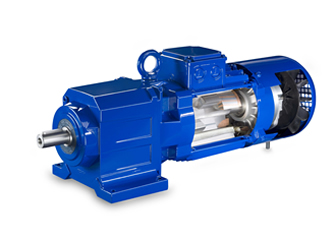
Just ten years ago, headline efficiency figures could only be dreamed of, now manufacturers are chasing them, fuelled by the introduction of more stringent IE efficiency classes. It's obviously a positive thing for the industry, but it makes you think is motor efficiency just the tip of the iceberg?
High efficiency (IE2), premium efficiency (IE3) and super premium efficiency (future IE4) motors manufacturer, Bauer Gear Motor is well placed to understand the value that a motor’s performance can place on the end-user’s running costs. However, its engineers are keen to stress to anybody who asks them that the motor is just one piece of the puzzle.
Rather than breaking down the drivetrain into different sections and focussing on a single component, such as the motor, Bauer believes that a view should be taken of a single, ‘Electro-Mechanical’ package; one which must be fully integrated to achieve maximum performance. In fact, despite the current focus on motor efficiency, the potential energy savings throughout the drivetrain can typically be distributed via the ‘ZVEI’ model:
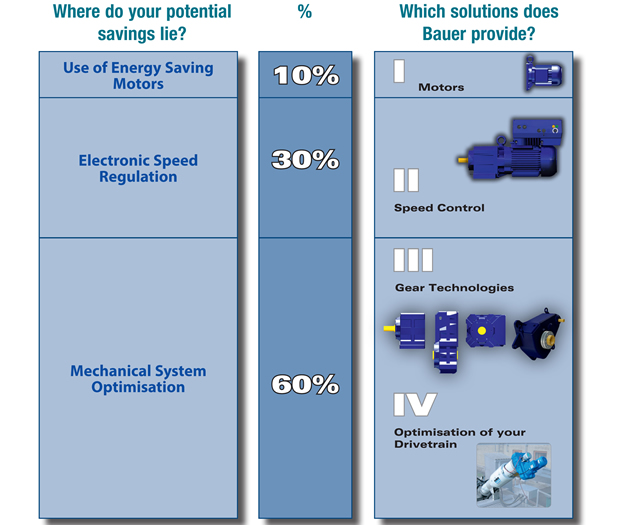
As the model shows, while it’s motors that are currently grabbing the headlines for development, there’s no point specifying the latest motor if the foundations aren’t already in order.
Using a speed control device to monitor and regulate a motor will straightaway make a significant improvement to any application that doesn’t require the motor to operate at full load at all times. In fact, even when operating at full load, a motor with a variable speed drive installed will still be more efficient at start-up.
The importance of speed control in real world efficiency is recognised by the introduction of Regulation 640/2009. This stipulates that from 1st January 2015 any installation in Europe where an IE2 rated motor between 7.5-375kW is specified, it must be installed with a Variable Frequency Drive (VFD).
Bauer has developed relationships with many of the leading manufacturers of speed control solutions to work hand-in-hand with its products to maximise the efficiency of its systems.
If it’s the speed control device that unlocks the potential of a modern motor, then it’s the mechanical components of a drive train that transmits the potential throughout the system. Within the electro-mechanical package, the mechanical components can be broken down into two sub-groups: gear technologies and drivetrain optimisation.
Specifying the most efficient gearbox allows you to transmit a larger percentage of the motor’s power for its intended function. A well specified and efficient gearbox will avoid unnecessary oversizing, saving money from the outset, and reducing system losses in operation. It’s these system losses that are a major factor in the EN50598 standard, which awards the new IES efficiency classes based on the efficiency of the complete power drive system.
Bauer has been manufacturing Gear Technologies since 1927, throughout these nearly 90 years it has always strived to offer the most efficient and reliable solutions possible. It’s found that offering modular solutions makes it easier to build bespoke packages with ideal reduction ratios for a given application. Its models include the helical BG series, parallel shaft BF series, bevel BK series and worm drive BS series. Application specific models are also available; including a stainless steel version which, when combined with its twin motor, creates the world’s first modular stainless steel IE4 permanent magnetic synchronous geared motor for the food and beverage industry.
Drivetrain optimisation is the last piece of the puzzle, but no less important than the considerations that have come before it. Once each aspect of the drivetrain has been specified, it must then be integrated into the machine with as much efficiency as possible. This requires an in-depth understanding of the drivetrain as well as the specific demands of a given industry, which is why Bauer has a team of application experts who specialise in different industries.
None of this is to say that the steady improvements in motor efficiency are unimportant. The gains that have been made in the last decade are staggering, and beyond comparison to the relatively mature, and therefore slowly developing gear and drivetrain technology. It’s important that an efficient mechanical system is specified as a foundation, but, once that’s in place, significant savings can be made by combining the latest electric motors with well integrated inverter drives.
To return to the iceberg analogy, the advancement being made within motor technology really is the visible tip. It’s attention grabbing which helps make us realise that system efficiency is something that we should be taking action over. However, the real consideration lies beneath, because without a properly specified drive train, an IE4 motor on its own will never meet the full efficiency potential.
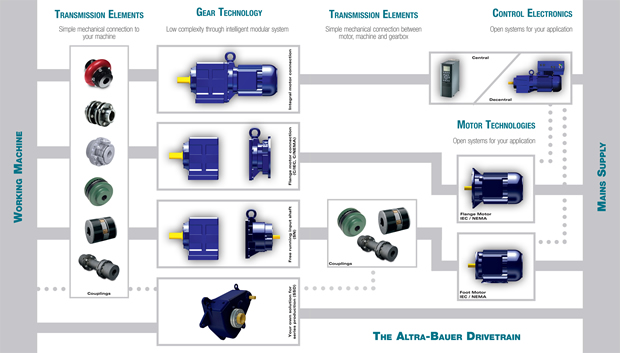
Similar articles
More from Bauer Gear Motor GmbH
- Keeping water treatment systems running through flood conditions 5th March 2018
- What role do motors and drives play in the water industry? 22nd June 2017
- Are motors the missing puzzle piece in drive train efficiency puzzle? 1st September 2016
- Bauer delivers efficiency for Pharmaceutical sector 10th May 2016

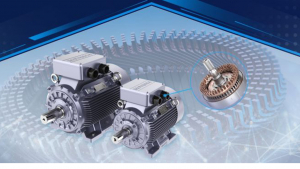
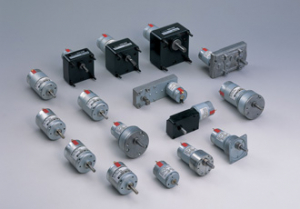
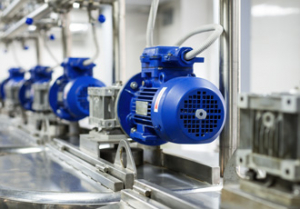








Write a comment
No comments